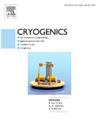Effect of martensitic transformation on cryogenic thermal conductivity and specific heat capacity of S30408 austenitic stainless steel
IF 2.1
3区 工程技术
Q3 PHYSICS, APPLIED
引用次数: 0
Abstract
Austenitic stainless steel S30408 is widely used in cryogenic equipment manufacturing due to its excellent cryogenic mechanical properties. However, the influence of martensitic transformation induced by plastic deformation and cryogenic environments during processing or service on its thermophysical properties remains unclear. In this study, room-temperature tensile deformation (0 %, 5 %, 12 %, 20 %, and 30 % plastic strains) and liquid nitrogen aging treatments were employed to induce varying martensite phase contents (0 %–36.6 %). The mechanisms of martensitic transformation on the cryogenic thermal conductivity and specific heat capacity of S30408 were systematically investigated. Using steady-state axial heat flow and relaxation calorimetry methods, the variations in thermal conductivity and specific heat capacity within the 20 K–300 K temperature range were measured. Results indicate that increased martensite content leads to a significant rise in lattice defects (slip bands, twins), enhanced electron–phonon scattering, and consequently, a marked reduction in both thermal conductivity and specific heat capacity. Within the 20 K–300 K temperature range, the thermal conductivity and specific heat capacity of samples with 30 % plastic deformation (36.6 % martensite content) decreased by an average of 27 % and 20 %, respectively, compared to undeformed samples. Further analysis revealed a linear negative correlation between thermophysical properties (thermal conductivity and specific heat capacity) and martensite content at specific temperatures (20 K, 77 K, 110 K, 300 K), with phase transformation exerting a more pronounced influence on thermophysical properties at the relatively higher temperature range within the low-temperature zone. This study elucidates the regulatory mechanism of martensitic transformation on the cryogenic thermophysical properties of austenitic stainless steel, providing critical data support for thermal performance design and service safety evaluation of cryogenic equipment.
马氏体相变对S30408奥氏体不锈钢低温导热系数和比热容的影响
奥氏体不锈钢S30408由于其优异的低温机械性能,被广泛应用于低温设备制造中。然而,在加工或使用过程中由塑性变形和低温环境引起的马氏体相变对其热物理性能的影响尚不清楚。在本研究中,采用室温拉伸变形(0%、5%、12%、20%和30%塑性应变)和液氮时效处理诱导不同马氏体相含量(0% - 36.6%)。系统地研究了马氏体相变对S30408低温导热系数和比热容的影响机理。采用稳态轴向热流和松弛量热法,测量了20 K ~ 300 K温度范围内的导热系数和比热容的变化。结果表明,马氏体含量的增加导致晶格缺陷(滑移带、孪晶)的显著增加,电子-声子散射增强,从而导致导热系数和比热容的显著降低。在20 K ~ 300 K温度范围内,塑性变形30%(马氏体含量36.6%)的试样的导热系数和比热容分别比未变形试样平均降低27%和20%。进一步分析发现,在特定温度(20 K, 77 K, 110 K, 300 K)下,热物性(导热系数和比热容)与马氏体含量呈线性负相关,在低温区相对较高的温度范围内,相变对热物性的影响更为明显。本研究阐明了马氏体相变对奥氏体不锈钢低温热物理性能的调控机制,为低温设备热性能设计和使用安全性评价提供了关键数据支持。
本文章由计算机程序翻译,如有差异,请以英文原文为准。
求助全文
约1分钟内获得全文
求助全文
来源期刊

Cryogenics
物理-热力学
CiteScore
3.80
自引率
9.50%
发文量
0
审稿时长
2.1 months
期刊介绍:
Cryogenics is the world''s leading journal focusing on all aspects of cryoengineering and cryogenics. Papers published in Cryogenics cover a wide variety of subjects in low temperature engineering and research. Among the areas covered are:
- Applications of superconductivity: magnets, electronics, devices
- Superconductors and their properties
- Properties of materials: metals, alloys, composites, polymers, insulations
- New applications of cryogenic technology to processes, devices, machinery
- Refrigeration and liquefaction technology
- Thermodynamics
- Fluid properties and fluid mechanics
- Heat transfer
- Thermometry and measurement science
- Cryogenics in medicine
- Cryoelectronics
 求助内容:
求助内容: 应助结果提醒方式:
应助结果提醒方式:


